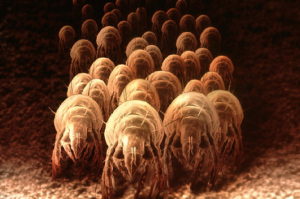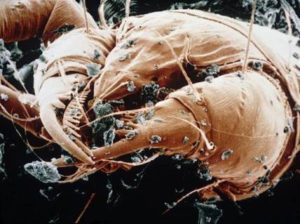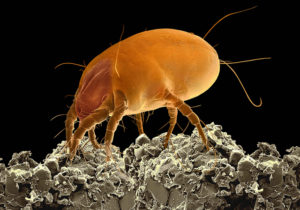Air Ducts & Dust Mites

Most people are disgusted, even insulted to hear that their homes are infested with dust mites. There could be anywhere from 100,000 to hundreds of millions living throughout your home. Living in/on your beds, bedding, couches, chairs, carpets, air ducts, etc… Like all living things, dust mites need food, water and shelter to survive, but they are not too picky so they live just about anywhere. The skin cells you shed every day are their primary food source. Moisture in the air is their source of water because they do not drink, they absorb.
I’m sure you’re not doing it on purpose, but you are providing dust mites with the perfect habitat. You can’t see them, you can’t smell them, and they don’t cause any destruction. You’ve managed to live with them all these years without even knowing they were there. So what’s the big deal? The dust mites themselves are harmless: they don’t crawl on you, they don’t bite, they don’t burrow under the skin, they don’t carry disease, and they don’t fly around in the air. So just what is so bad about dust mites? It’s the dust mites’ feces and the dried body parts of dust mites, politely called dust mite allergen, that negatively affect millions of people.
Dust Mites are microscopic little bugs about 1/100th of an inch. It takes a 10X magnification to see them. They are in the arachnid family more closely related to spiders and ticks, they are everywhere and can cause big trouble. Their presence has nothing to do with the cleanliness of your home, so you needn’t be insulted. Dust mites require only humidity and a food source to survive and thrive. They live in common house dust which is made up of dead skin, hair etc. which provides the perfect environment for them to live by feeding on the tiny scales of dead skin that people naturally slough off. Since an average person sheds about 0.3-0.45 kg of skin per year, one person produces enough dead skin to feed nearly a million dust mites. Dust mites in bedding obtain moisture from human breath, perspiration, and saliva. Even though you can’t see them, you can rest assured that they are there if their basic needs are being met.

These dust mites which live in your bed, carpet, furniture and air ducts are considered to be one of the most common causes of asthma worldwide. In their larval stage, dust mites have 6 legs, and in their post larval stage have 8 legs. The average life span of a male house dust mite is approximately 19-30 days. A mated female house dust mite can live of up to two months, laying eggs for the last 30 days of her life. The dust mite is one of the most significant sources of household allergens, and is known to complicate allergic asthma, rhinitis, conjunctivitis and dermatitis. DerP1, an important protein responsible for allergic reactions, is an enzyme found in dust mite feces. Just one gram of household dust (approximately half of a teaspoon) contains as many as 1,000 dust mites. That same gram of dust can hold 250,000 of their fecal pellets. A dust mite will produce 20 fecal pellets per day, which is 200 times its own body weight in feces during its short lifetime.
According to the American College of Asthma, Allergy & Immunology, approximately 10 percent of Americans exhibit allergic sensitivity to dust mites. In the spring, pollen aggravates allergies, and dust mite infestations make it worse. In addition to causing an allergic reaction, dust mite allergen can also trigger an asthma attack. According to William F. Lyon of Ohio State University, “Estimates are that dust mites may be a factor in 50 to 80 percent of asthmatics” and “an exposure to the mites in the first, crucial year of life can trigger a lifelong allergy.” In 2005, the National Environmental Education Foundation published “Environmental Management of Pediatric Asthma” that stated guidelines for using environmental controls to reduce the severity of asthma symptoms in children already diagnosed with asthma. One of the six guidelines recommends “Reducing dust mites in the home.”

Routine cleaning of your air ducts, bedding and carpeting are your front line defenses against dust mite allergens. Precision Air Duct Cleaning thoroughly cleans out your entire air duct and HVAC system in order to remove all the dirt and debris build up that gives food and a home to these tiny pests.
You may be wondering if this little critter is causing your allergy symptoms. Since dust mites populate your home, you may be reacting to dust mite allergen if your allergy symptoms get worse when your home. Allergy symptoms such as headache, sneezing, congestion, runny nose or watery eyes tend to get worse during the night or be worse on awakening after a night spent inhaling dust mite allergen. However, the only way to know for sure that you are allergic to dust mite allergen is to visit an allergist or other doctor who does allergy testing.